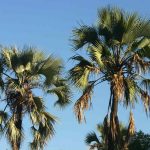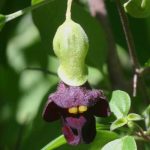TREE LIFE
FEBRUARY 1991
MASHONALAND CALENDAR
Tuesday 5th February: Botanic Garden walk with Tom Muller. Park your car at the Herbarium where we will meet Tom at 4.45 far 5 p.m.
Sunday 17th February: Many members will remember our outing to Mrs T.I.E. Verwoerd’s Farm/Riding School at Wingate in January 1988, when later in the afternoon Scolopia zeyheri was discovered along the river by Fr. Hugh Ross. Today we will carry on from there following the river to see what other exciting species await discovery.
Saturday 23rd February: Walk with Mark in the Makuvisi woodland, meeting in the car park at 1500 hours.
Tuesday 5th March: Botanic Garden Walk with Tom
Easter weekend : See Matabeleland Calendar
MATABELELAND CALENDAR
Sunday 3rd February: Whitestones School, Burnside, to meet up with some of the pupils. Meet there at 0830 hours bringing tea and chairs. This will be a morning only.
Sunday 17th February: Meet at 0830 hours at Val Dees’ house, 135 Crouch Road, Matshaumhlope A morning outing into Val’s very interesting and diverse neighbourhood. Bring tea and chairs.
Sunday 3rd March: we go to Mr Roy Stevens‘ Shumba Shave Mkulu, on the fringes of the Matopos – a fabulous area – (last time we recorded 120 species). We are promised new walks. Bring a really PORTABLE LUNCH, as it will be a long hike for those able. An all-day outing. Meet at Retreat, 0830 hours. It will be about 50 km from there.
Sunday 17th March: Back to Richmond Nature Dark (near the lower Umgusa dam) where the first stage of development is taking place – and to finish off a list of trees for use in the area. Meet at Falls Road Motors at 8.00 a.m. to continue along for a further 4 km on good road. Morning only – bring tea chairs and binocs!
FRIDAY 29th MARCH – EASTER WEEK END: Initial arrangements have been made for at least 30 people to be housed in and around the Ben Accord Farmstead. About 12 be accommodated on own beds in 3 bedrooms/lounge. A large veranda can also be used plus tents around the security fenced garden. Security-fenced? That is to save being trampled on by giraffe/kudu/sable/teessebe/impala, etc. from the game reserve! Very close to the Nalatale Ruins, a spectacular place. Ablutions are a bit spartan, but might be improved. About 30 km east of Shangani – on a first come, first served basis. Or day visits from Bulawayo. Happy Easter. Phone Ken Blake on Bulawayo 61384 or Maureen Silva-Jones on Harare 739711 (both line numbers) to reserve your place.
STOP PRESS There is a strong possibility that neighbouring farmers will be able to offer accommodation as well.
MATABELELAND NOTES On Tuesday, January 1st, we had a splendid start to our Tree Year with a very good day, at the Blakes’ Rocky Glen. As promised, the river was running, and trees were at their best. We began with a well prepared quiz of 20 trees, and eventually had a most excellent lunch, organised by Angela Murray. Finally, to shake this down, we had good tree walk, around the property. In all we found 51 species, quite near the house. Of note were Acacia fleckii, Canthium lactescens, Clerodendrum myricoides, Commiphora africana,
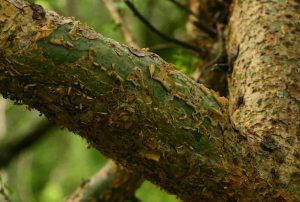
Commiphora schimperi. Photo: Bart Wursten. Source: Flora of Zimbabwe.
Commiphora schimperi, C. glandulosa (formerly C. pyracanthoides), C. mossambicensis, Erythrina latissima, Ficus abutilifolia and F. glumosa, with leaves nearly as big as F. abutilifolia we only meet occasionally, this one was notable for its bright red veins, Gardenia volkensii, a large specimen, many Kirkia acuminata, Lonchocarpus capassa, Mundulea sericea, Pavetta gardeniifolia and Pavetta schumanniana, both flowering, and abnormally dark, owing perhaps to some extra nitrogen, Peltophorum africanum, flowering, Pouzoulzis mixta, Rhus leptodictya, Rhus pyroides, Terminalia trichopoda, lots of Vangueria infausta. On the approach, just near the Motor Race Track, there was a very fine Pterocarpus lucens, (Formerly P. antunesii), in full handsome golden flower. This is a tree we tend only to notice, when in flower. I think that there are more around than we realise.
-Charles Sykes
ARBOREAL INDIGESTION AT THE GWAYI
Several months ago, Cathy Rogers, ecology officer (terrestrial) of the National Parks and Wildlife, offered to conduct us around the Forests of the Gwayi River – she is also Rose Rigden’s daughter! On Friday, 18th January, 21 members of the Matabeleland Branch independently arrived at the Gwaai River Hotel having passed the beautiful flowering Baikiaea plurijuga (teak), the showy white flowers of Bauhinia petersiana and the yellow flowers of the delicately and long-petioled leaved Bauhinia tomentosa. In fact, the Victoria Falls Road is a mass of greenery of all shades from the silver of Terminalia sericea, the lush Ricinodendron rautanenii (balsawood), the mopane-like leaves of Guibourtia coleosperma to the denseness of Adansonia digitata (baobab) — and of course, the many flowering Acacias.
Promptly at 0800 hours the next morning we were appropriately booted, (it had rained during the night) and set off along a rough, stoney and very muddy track deep into the forest, forest, where Cathy and Neil have a cleared an area for vegetable growing away from the river bank.
The approximate count of trees for the weekend is about 95, of which about a third were new to us, and the members were treated to the usual light-hearted arguments between Charles, Ian, Thora and Betty – but this time refereed by Cathy! we were introduced to Diospyros quiloensis, usually small but with a beautiful collection of coloured crinkly leaves; the Baphia massaiensis; Acacia robusta subsp clavigera, a new one for us, very different from subsp robusta, Canthium frangula a rather Catunaregam like tree with spines; Croton megalobotrys in profusion; the beautifull ooking and sounding Friesodielsia obovata; the spectacular leaves of Gardenia resiniflua; the large and small frilly leaves of Combretum elaeagnoides ; the very tall riverine
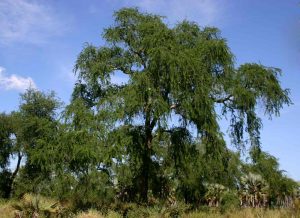
Faidherbia albida. Photo: Bart Wursten. Source: Flora of Zimbabwe.
Faidherbia albida (apple-ring acacia); the smaller, but showy Acacia eriocarpa; Commiphora edulis; Phyllanthus reticulatus; the potato smell creeper; the poisonous Strychnos potatorum; Xylopia odoratissima; Vangueria randii and infausta; the guava-like Vangueriopsis lanciflora; Scolopia zeyheri; the large-leaved Terminalia prunioides and T. stenostachya; the old faithful- Zanthoxylum chalybeum; and overshadowing this lot, some enormous Colophospermum mopane and the Branch’s recent find, the beautiful golden yellow flowering Pterocarpus lucens. After a hectic and humid morning it was welcome to return to the facilities of the hotel (lunch, swimming, lazing) before returning to an area closer home for a late afternoon outing. Although only about 3 km from the original area we encountered kalahari sand and started all over again! First off was the delicately silver-haloed leaves of Combretum psidioides; followed by a startling Monotes glabor; the drooping light green of Erythrophleum africanum (ordeal tree); the very tall Lonchocarpus nelsii from which even Dennis couldn’t collect leaves; the strange-named Erythrococca menyhartii; the willow boscia, Boscia salicifolia; the vicious scattered thorns of Acacia ataxacantha; a few Brachystegia spiciformis and Securidaca longepedunculata (violet tree); and a new one for us, the Combretum mossambicense with its stiff leaves; many extraordinarily large-leaved Croton gratissimus; the thorny nigrescens-like Dalbergia melanoxylon; the Erythroxylum zambesiacum; and the unusual Ziziphus abyssinica with its hairy—surfaced, soft leaves. Touches of colour were made by the fruiting Ximenia americana which Thora offered around (only to the “new” members – ha, ha!) and the spectacular orange flame lilies. Once safely back at the hotel, Cathy informed us that only two days before at that last area, a lion had killed a cow! So of course he wasn’t hungry anymore!
Indigestion had sat in with trees and Sunday was set aside for a sortie to find the elusive Narina trogon and Emerald Cuckoo – both not seen but after much tramping through the magnificent bush — we got close!
A wonderful weekend which will live on as reports of the difficult Grewias and Figs come to light! The weather was pre-arranged to have clear days and wet nights, the hotel has reasonable rates, meals and accommodation, is ideally situated for the Hwange National Park – and will be visited again by the Tree Society, as our teacher members remarked – “for revision”! A nice touch from the hotel was a free meal for the Rogers for being the cause of bringing the Tree Society!
Thank you Cathy and Neil for a wonderful excursion into the wilds.
-KEN BLAKE
THE MARR—LEVINS FARM IN THE NORA VALLEY
A bright Sunday morning, a winding dirt road, green green grass, tree clad kopjes and five Tree Society signs later we found ourselves at a small patch of woodland below the Marr-Levin’s house. It was a day of fruit and flowers.
A Syzygium quineense with plenty of ripe purple fruit detained us. I’ve never eaten these before. The skin peeled off easily revealing the white flesh inside, – slightly mouth puckering to taste but nice enough to have me reaching for the next. Then there were several Ochna puberula in amongst the rocks, which were covered with red-sepaled fruit. A sight worth a photograph. An Ormocarpum with a thick corky bark had us wondering. I think it may have been O. triohocargum – just possible according to the distribution map, but there were no pods for easy verification. Apparently, hybrids between O.kirkii and O.t richocarpum may occur.
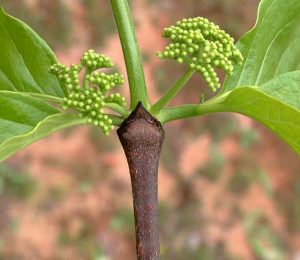
Afrocanthium lactescens. Photo: Rob Burrett. Source: Flora of Zimbabwe.
Afrocanthium lactescens and Azanza garckeana (both in flower; were being discussed when the Meyers parrot, which we’d heard calling for sometime, suddenly flashed through the trees. The conversation then veered off on to tooth picks – Diospyros lycioides for a red stained mouth, Euclea divinorum for a yellow stained mouth plus benefits deemed suitable for men but not women in the Shona culture! There were several Acacia sieberiana within fifty metres of each other with amazing bark variation. One had a deeply fissured, corky trunk, one had yellow papery bark which was peeling off from ground level to twig-top, and several were quite nondescript.
After lunch we walked to see some corn grinding/gold grinding rocks (or were they just designed to be bird baths?). Lovely ripe mahobohobo fruit and sour plums (Ximenia caffra) were to be had along the way. An exciting find here, was the shrub Psychotria kirkii. This looks somewhat similar to a Pavetta, with prominent bacterial nodules clearly visible as black dots on the under surface of leaves. The Flowers however are very different to a Pavetta‘s. Finally the day would not have been complete without a visit to the beacon. Thanks to two metal ladders we stood on the rock top and surveyed the surroundings – close at hand the Nora valley with the P T C tower at Sitra potteries, than the kopje sprinkled plain stretching towards Mutoko with rain showers moving across it, and lastly the whole back of Ngomakarira. Below us Hymenodictyon floribundum were in flower — huge trees, 6 metres or so in height with surprisingly fragrant flower spikes. Kim pointed out that the interpetiol stipules of Hymenodictyon have black teeth along their edges — they can be seen even without a lens.
-Tessa Ball
NYARUPINDA CATCHMENT – DECEMBER & JANUARY 1990/91
This letter is dedicated to the memory of our Chairman, Dick Hicks who was suddenly taken away from us. Our deepest sympathy to his family and to Maureen- It would have pleased Dick to know that one of his flock had six drawings accepted by the editor of the Proteaceae Atlas Newsletter for September 1990. The wood of Protea petiolaris and Macadamia ternifolia were the cover illustration. Ziziphus mucronata in the round featured in the contribution because its growth rings and very fine (narrow) rays contract with the broad rays which occur in some Proteaceous woods. To introduce the subject there was a diagram to explain why the three planes of wood are so different from each other. The presentation of this material taught me a lesson; i.e. to number the drawings and explain them elsewhere, this gives the artwork more impact. Luckily the photocopying did justice to the black and white illustrations.
Whilst on holiday in England we stayed with a nephew who is the Gamekeeper at Powderham Castle in South Devon. He rears game birds in woods which were ravaged by the storm early in 1990. He showed us the damage to oaks, sweet chestnut, beach and cedars, some of which had been raised by local nursery men in the early 1700’s. For many months Eddie Graves and the forester have been clearing the ground for re-planting. Amongst the timber debris there were sample sized pieces of Fagus sylvatica (European Beech) which were brought home to compare with Faurea sp. popularly named African Beechwood. Another find was wonderfully smooth burrs from the cedars. These are the size and shape of a potato, one end tapers abruptly to a point. Their origin has not yet been explained to me. This item is a touch sensation which has been added to a wooden bowl of curiosities.
Reference TREE LIFE No. 130. OPERATION CATENA
If the catena route were followed today it would take much longer because there is more to see, many one leaf, one flower-stem plants have sprung up as a result of 143mm rain which fell during the latter half of November and early December. Undisturbed Brachystegia woodland, termite mounds and the fireguard lines are the places where species of the following genera have been noted; Chlorophytum (like‘hens and chicks‘); Dipcadi, with green flowers; Eriospermum; Eloriosa; Gladiolus (almost black, atro-purpurea); Nervilia with a pleated leaf; Ledebouria (was Scilla); Raphionacme (longifolia is widespread in this district); Anthericum (grass flower); Urginea (slangkop); and finally a member of ASDHDDELACEAE whose flowers are closed until the afternoon. Many of these gems are ephemeral and ethereal and this protects them from man and beast.
NEW BLOOMS
The list is long, only a few will be mentioned; along the edges of vleis Acacia amythethophylla is earlier than usual. Perhaps the most beautiful flower at the moment is that of Bauhinia petersiana it is closely followed by Grewia avellana which is a many-stemmed shrub belonging to Meg’s Taxon 3 because it has fruit with 2-4 deeply divided lobes, the leaf base is symmetrical and the blossom is white. Its sepals are like petals and longer than the petals, the diameter of the flower is 4,5 cm., when held upside down it may be trimmed with scissors to look like a baobab flower, albeit a very small one. This is fun as well as being a botanical exercise, because the family TILIACEAE to which Grewia belongs is classified next but one (MALVACEAE) to the BOMBACEAE family to which the baobab belongs. Six snips do the trick and the taxonomic sequence (Engler and Drantl) of these three Families will never be forgotten. The flowers of Terminalia mollis were hidden amongst the foliage at the top of this tall tree. On December 10th it was a surprise to see many clusters of the palest green fruits. At the moment each is 3 times as long as it is wide, the apex is rounded and the base tapers, as it matures the shape changes, from oblong to shield shaped.
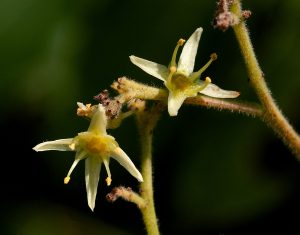
Kirkia acuminata. Photo: Bart Wursten. Source: Flora of Zimbabwe.
Kirkia acuminata’s blossom is usually inaccessible. Today an attempt will be made to obtain a sample. It occurs above Elephantorrhiza goetzei and in the company of Afzelia quanzensis, the latter was floriferous yet produces so few pods. Kirkia acuminata has not received much attention in these pages, so here goes. The tree is sacred to some African tribes. Thanks to Stephen Mavi for those notes which were made many decades ago. Mubvumira and umvumila are Shona words meaning ‘to agree with‘ and refer to a legend about this tree. The spirit of Chaminuka looked for a place to dwell and eventually, probably a particular specimen of Kirkia allowed the spirit to enter it. The name umvumila (variously spelt) was applied to all specimens of this tree, which then became holy among the Mashona people. Other sacred trees are Pseudolachnostylis maprouneifolia and Parinari curatellifolia. The mushava (Monotes esp.) are revered by the people of the Buhera area in the south of Zimbabwe. There is often a ‘celestial hum’ of insects near these trees.
UMVIMEELA DYKE – It may not be general knowledge that to the east and west of the Great Dyke there are mini dykes; the technical name for them is satellite dyke. The formation on the west side is called Umvimeela and that on the other side is called the East Dyke. Both are well wooded because the soil is derived from gabbro. which is related chemically to Dolerite. The western satellite is characterised by Kirkia acuminata, the terrain is a boulder strewn ridge about 25km wide which intrudes the granite as does the Great Dyke. In Makonde and beyond, the Umvimeala Dyke can be identified on Kildonan, Kyle, Lone Cow; Mpinge Ranch, and Gurungwe Estate where it is displaced about 10km east on account of the Gurungwe Fault. This Fault displaced the Great Dyke similarly. At this point the Umvimeela Dyke is in the position of the Great Dyke prior to the Fault, and it ends at the Zambezi Escarpment.
In the library at the Geological Survey Office there is a bulletin by Dr. B G Worst called “The Great Dyke of Southern Rhodesia.” There is a set of 9 maps which require to be spread out obliquely over a distance of about 8 metres, along a verandah at Maufe Buildings. This is an unforgettable experience.
There is an article of botanical interest concerning Aloes and other succulents, written by Mr. Michael Kimberley in “Wild Zimbabwe”, No. 51 March 1988.
On the back cover of “Science News” of April 1990 or thereabout there is an illustrated article on a little orchid called Disperis. This species with a long name was found in this catchment in February 1978. Only now its identity has been ascertained. The author was pleased that somebody took notice of his contribution to this publication.
Just a brief reference to an unusual spider in the Miombo woodland, its 3m wide golden web complete with almond-fruit-sized egg case, funnel and trapped rose beetles and damsel flies has withstood several violent storms. Earlier in the season a hammock in the web held numerous Brachystegia flowers. The spider is sluggish and rests with its legs tucked up under its head. Its abdomen is dimpled and white with 2 black ‘shoulder patches‘ and a single larger black mark above the spinaret. It has to be persuaded to leave its funnel to be observed. Mrs. Minshull will be informed of this arachnid and hopefully there will be more information about it in the next Tree Life.
Dickie and Maurice Graves
MUKUVISI WOODLAND NOTES : DECEMBER 1990/JANUARY 1991
Planting rains fell shortly after I wrote the last notes, but there was not enough run—off to make the Chiraura flow, so virtual drought conditions still prevailed in the game area.
Ochna is a genus well represented in the woodland. We have all three of the ‘frequent’ high veld species present. O. schweinfurthiana is the most common, a fact we owe to a lucky combination of an exceptional fruiting year, followed by good rains and then the start of our fire control. O. puberula is rare here, probably our combined observations amount to only two or three plants among rocks along the Mukuvisi.
Some kind of survey is long overdue, designed to measure recent eland impact which I am sure is very heavy.
The last time I had some kind of fever, I dreamt about Ochna. In the dream I was listening to a speech at the United Nations and Ochna was referred to as the Mickey Mouse Tree. A storm of protest followed and the chair ruled that use of this common name was permitted because “it is the name given in Trees of South Africa by Coates Palgrave”.
When I was properly awake, I could not wait to look it up, happily it was only a nightmare, Coates Palgrave’s name for Ochna is Ochna. Only Bob Hargreaves in my experience uses this horrible appellation for what is one of the loveliest and fascinating flowering and fruiting plants. In the woodland we also have the dwarfs – O. macrocaylx and O. leptoclada.
I often ponder what precise environmental factors caused these dwarf plants to retreat underground. Mostly heat and drought, presumably, but whatever the original cause, the descendants today obviously find an advantage in this mode of existence.
Now, nothing to do with the woodland, except we did start agro-forestry experiments there some years ago. They have been discontinued, however, the experiments continue in my own garden and I would like to announce have bred another hybrid, not a tree, an onion in fact, and I would like to advertise this to anyone connected with plant breeding, my cross onion my be of genetic value to someone.
When I first found it I figured I might have a money spinner. It is the child of what I call ‘shallot’ the spring onion like things, and the ordinary leek, what Welshmen plant on the centre spot and between the posts at rugby international matches.
Had it grown up to have the physique of the leek, and the reproduction (vegetatively) of the shallot, I would now be trying to corner the commercial leek market. The reverse was true, whilst it reproduces like a shallot it looks simply like a miniature leek, smaller than a shallot, of no obvious culinary value at all.
So, if any plant breeder is interested and should become aware of this through Tree Life, as I say I will be happy to supply plants. I cannot see any value except for future breeding experiments.
George Hall.
PERMACULTURE ASSOCIATION OF ZIMBABWE
Permaculture has been described as “a permanent, self sustaining system of agriculture, adaptable to both rural and urban situations, designed to produce an efficient, low maintenance, optimally productive integration of trees, plants, animals, natural features and man-made physical structures, and human activities, within specific environments, with the ultimate goal of ecological stability and diversity in a system designed for conservation of soil, water, energy and all other natural resources.”
The Permaculture Association aims to be a communication lifeline for people interested in information about designing and developing truly sustainable land use which at the same time does not create dependency on outside inputs. As the need for Ecology and Economics to merge is recognized, it is important that practical possibilities are shared. PAZ will
i) produce 4 newsletters per year;
ii) act as a medium for species exchange;
iii) become a forum for trials;
iv) become an information pool of goods and services offered by members.
SUBSCRIPTION For 1990/91 $10. (Applications For lower subscription rates will be considered). Payment of subscription for a year will entitle you to all copies of the newsletter for that year.
Please write to PAZ, P O Box 8515 Causeway for further information.
CHIRINDA FOREST (CONTD) by B. Goldsmith (Forestry Commission)
Insects
In the rains one can come across small bright red millipedes. Among the many insects found, a fruit chafer Dicranorrhina polychrous is worthy of mention. This inch long beetle is completely iridescent with a shimmering broad bronze green body and shiny brown back. Heterorrhina alternate, another chafer beetle, is more slender, shiny metallic green. Both the above gorge themselves on fermenting fruit of Ficus sansibarica. Many attractive butterflies can be see in sunlit glades. There are several Papilio species or Swallowtails, fast flying Charaxes and the Gold Banded Forester. Mr. van Son was an avid butterfly collector. When he died in Pretoria, his wife and son motored to Chirinda to spread his ashes in the Forest. Fireflies gather in their hundreds on humid summer nights to create an earthly Fairyland. The cold light they radiate is caused by Luciferin which is remarkedly efficient. Ixodes psendorasies is a minute tick which is very active in summer. One is usually only aware of its presence when a persistent itch is felt on the upper thigh or abdomen. At this stage only two back legs can be seen. 0il or grease will smother it. Some people develop a nasty irritating red weal. Chirindites odendaali is a wingless grasshopper of the forest. Mr. Whellan, past entomologist, told me that he had to correct the specific title in Britain as the authorities had misspelt it. Safari ants are the forest scavengers. They can appear as if by magic, in their thousands, mainly in the wet weather. Young animals are quickly rendered helpless after the removal of the eyes. Our tortoise was killed by first being blinded. We had reared him from the egg stage. One is usually caught whilst standing. These half inch long reddish brown ants have no sting but they bite in unison. Again, some people are allergic to the painful nips. I have seen a newly hatched clutch of Bantam chicks torn to shreds. The hen would have shared the same fate had we not rescued her, as she was puzzled by the biting but would not leave her chicks. Her body was covered in ants. My small long haired dog almost succumbed. His body was teaming with these pests. Lord and Lady Aldenham, related to Sir Humphrey Gibbs, were attacked whilst I was escorting them to the Big Tree. I advised them to keep moving and then tactfully retreated. Lady Aldenham divested herself of some of her garments. There were a few shouts of surprised pain before things settled down. Agitated movement triggers off a signal for these insects to attack en masse.
Hopefully this paper has given some idea of the appearance and delicate ecological balance of Chirinda. Here is a unique entity enjoying its own microclimate, with most of the evidence pointing to the fact that it is relic forest.
(Supplied by The Zimbabwe Rhodesia Science News Vol. 14, No. 3 – March 1980
KIM DAMSTRA CHAIRMAN


